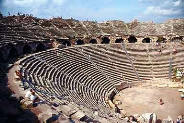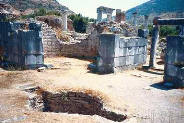Marmaris history
The Marmaris history blended is reaching back far in the ancient times. First becomes known in the fourth century B.C. as the city of Physkos, a part of the Rhodian Empire. The Rhodian Empire was formed in 408 B.C. with the unification of three independent Rhodian cities, Lindos, Ialysos, and Kamiros into a mighty single state. The capital of which was the newly constructed city of Rhodes. Previously these independent cities had possessed territories on the mainland of Asia Minor and with the formation of the new state, this area, primarily the Loryma and Datca peninsulas: those bodies of land stretching from present day Marmaris in the east, to the ruins of Loryma and Knidos in the west became the Rhodian Empire. The Inhabitants of the Rhodian Empire were accorded all rights as full citizens of Rhodes. Marmaris which was called Physkos in ancient times, was one of the most important cities and the was mentioned by name in the official correspondence of the time. According to Bean, Physkos was attached to the city of Lindos and as inscriptions show was incorporated into the Rhodian state at the time of Alexander the Great, around 345 B.C.
 |
 |
 |
Of this period of Marmaris, history only very little remains in present day Marmaris. The ancient acropolis stood about a mile to the north of modern harbor high up on a hill, known today as Asar Tepe. A walk up the mountain will bring you to the remains of the old walls with very little of note inside them. It is said that the inhabitants of Physkos virtually destroyed the town rather than surrender it to Alexander intact. In the face of approaching armies at the time. That following the decline of Physkos in the second century B.C. the stones and foundations that made up the city were carried away for building purposes elsewhere or were used as ships ballast, little of the original city remains today.
The next important event during the history of Marmaris was almost thousand years later, in mid-fifteenth century. When the Ottoman Empire begun to rise. After the efforts of Sultan Mehmet II. Who succeeded in conquering and uniting under one banner the various tribes and kingdoms of Asia Minor. Certainly, come of his greatest difficulties came from the Knights of St. John, who occupied the Dodecanese Islands. Based in Rhodes the Knights had fighted many years and were able to withstand the onslaughts of Mehmet II until a succeeding and more powerful Sultan came on the scene.
It was under Suleyman the Magnificent that Marmaris came under Ottoman control. In 1552 Suleyman assembled in the bay of Marmaris a fleet of over 300 ships and a force of 200.000 strong to challenge the Knights' headquarters on Rhodes. After many battles, the Knights had to give up and the Turks overtook Rhodes for the next four hundred years.